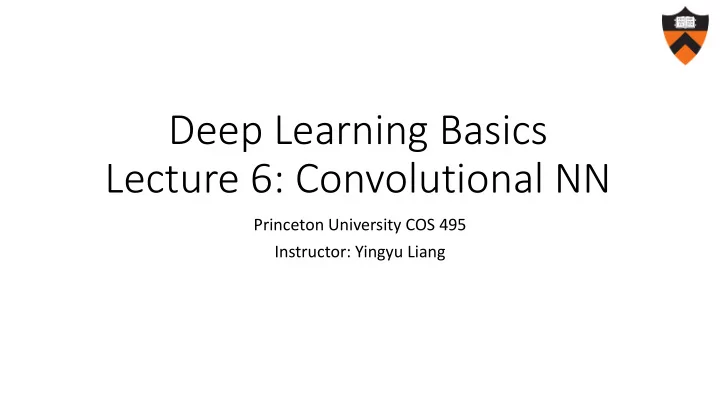

Deep Learning Basics Lecture 6: Convolutional NN Princeton University COS 495 Instructor: Yingyu Liang
Review: convolutional layers
Convolution: two dimensional case Input Kernel/filter a b c d w x e f g h y z i j k l wa + bx + bw + cx + ey + fz fy + gz Feature map
Convolutional layers the same weight shared for all output nodes 𝑛 output nodes 𝑙 kernel size 𝑜 input nodes Figure from Deep Learning, by Goodfellow, Bengio, and Courville
Terminology Figure from Deep Learning, by Goodfellow, Bengio, and Courville
Case study: LeNet-5
LeNet-5 • Proposed in “ Gradient-based learning applied to document recognition ” , by Yann LeCun, Leon Bottou, Yoshua Bengio and Patrick Haffner, in Proceedings of the IEEE, 1998
LeNet-5 • Proposed in “ Gradient-based learning applied to document recognition ” , by Yann LeCun, Leon Bottou, Yoshua Bengio and Patrick Haffner, in Proceedings of the IEEE, 1998 • Apply convolution on 2D images (MNIST) and use backpropagation
LeNet-5 • Proposed in “ Gradient-based learning applied to document recognition ” , by Yann LeCun, Leon Bottou, Yoshua Bengio and Patrick Haffner, in Proceedings of the IEEE, 1998 • Apply convolution on 2D images (MNIST) and use backpropagation • Structure: 2 convolutional layers (with pooling) + 3 fully connected layers • Input size: 32x32x1 • Convolution kernel size: 5x5 • Pooling: 2x2
LeNet-5 Figure from Gradient-based learning applied to document recognition, by Y. LeCun, L. Bottou, Y. Bengio and P. Haffner
LeNet-5 Figure from Gradient-based learning applied to document recognition, by Y. LeCun, L. Bottou, Y. Bengio and P. Haffner
LeNet-5 Filter: 5x5, stride: 1x1, #filters: 6 Figure from Gradient-based learning applied to document recognition, by Y. LeCun, L. Bottou, Y. Bengio and P. Haffner
LeNet-5 Pooling: 2x2, stride: 2 Figure from Gradient-based learning applied to document recognition, by Y. LeCun, L. Bottou, Y. Bengio and P. Haffner
LeNet-5 Filter: 5x5x6, stride: 1x1, #filters: 16 Figure from Gradient-based learning applied to document recognition, by Y. LeCun, L. Bottou, Y. Bengio and P. Haffner
LeNet-5 Pooling: 2x2, stride: 2 Figure from Gradient-based learning applied to document recognition, by Y. LeCun, L. Bottou, Y. Bengio and P. Haffner
LeNet-5 Weight matrix: 400x120 Figure from Gradient-based learning applied to document recognition, by Y. LeCun, L. Bottou, Y. Bengio and P. Haffner
Weight matrix: 84x10 LeNet-5 Weight matrix: 120x84 Figure from Gradient-based learning applied to document recognition, by Y. LeCun, L. Bottou, Y. Bengio and P. Haffner
Software platforms for CNN Updated in April 2016; checked more recent ones online
Platform: Marvin (marvin.is)
Platform: Marvin by
LeNet in Marvin: convolutional layer
LeNet in Marvin: pooling layer
LeNet in Marvin: fully connected layer
Platform: Caffe (caffe.berkeleyvision.org)
LeNet in Caffe
Platform: Tensorflow (tensorflow.org)
Platform: Tensorflow (tensorflow.org)
Platform: Tensorflow (tensorflow.org)
Others • Theano – CPU/GPU symbolic expression compiler in python (from MILA lab at University of Montreal) • Torch – provides a Matlab-like environment for state-of-the-art machine learning algorithms in lua • Lasagne - Lasagne is a lightweight library to build and train neural networks in Theano • See: http://deeplearning.net/software_links/
Optimization: momentum
Basic algorithms • Minimize the (regularized) empirical loss 1 𝑜 𝑜 σ 𝑢=1 𝑀 𝑆 𝜄 = 𝑚(𝜄, 𝑦 𝑢 , 𝑧 𝑢 ) + 𝑆(𝜄) where the hypothesis is parametrized by 𝜄 • Gradient descent 𝜄 𝑢+1 = 𝜄 𝑢 − 𝜃 𝑢 𝛼 𝑀 𝑆 𝜄 𝑢
Mini-batch stochastic gradient descent • Instead of one data point, work with a small batch of 𝑐 points (𝑦 𝑢𝑐+1, 𝑧 𝑢𝑐+1 ) ,…, (𝑦 𝑢𝑐+𝑐, 𝑧 𝑢𝑐+𝑐 ) • Update rule 1 𝜄 𝑢+1 = 𝜄 𝑢 − 𝜃 𝑢 𝛼 𝑐 𝑚 𝜄 𝑢 , 𝑦 𝑢𝑐+𝑗 , 𝑧 𝑢𝑐+𝑗 + 𝑆(𝜄 𝑢 ) 1≤𝑗≤𝑐
Momentum • Drawback of SGD: can be slow when gradient is small • Observation: when the gradient is consistent across consecutive steps, can take larger steps • Metaphor: rolling marble ball on gentle slope
Momentum Contour: loss function Path: SGD with momentum Arrow: stochastic gradient Figure from Deep Learning, by Goodfellow, Bengio, and Courville
Momentum • work with a small batch of 𝑐 points (𝑦 𝑢𝑐+1, 𝑧 𝑢𝑐+1 ) ,…, (𝑦 𝑢𝑐+𝑐, 𝑧 𝑢𝑐+𝑐 ) • Keep a momentum variable 𝑤 𝑢 , and set a decay rate 𝛽 • Update rule 1 𝑤 𝑢 = 𝛽𝑤 𝑢−1 − 𝜃 𝑢 𝛼 𝑐 𝑚 𝜄 𝑢 , 𝑦 𝑢𝑐+𝑗 , 𝑧 𝑢𝑐+𝑗 + 𝑆(𝜄 𝑢 ) 1≤𝑗≤𝑐 𝜄 𝑢+1 = 𝜄 𝑢 + 𝑤 𝑢
Momentum • Keep a momentum variable 𝑤 𝑢 , and set a decay rate 𝛽 • Update rule 1 𝑤 𝑢 = 𝛽𝑤 𝑢−1 − 𝜃 𝑢 𝛼 𝑐 𝑚 𝜄 𝑢 , 𝑦 𝑢𝑐+𝑗 , 𝑧 𝑢𝑐+𝑗 + 𝑆(𝜄 𝑢 ) 1≤𝑗≤𝑐 𝜄 𝑢+1 = 𝜄 𝑢 + 𝑤 𝑢 • Practical guide: 𝛽 is set to 0.5 until the initial learning stabilizes and then is increased to 0.9 or higher.
Recommend
More recommend